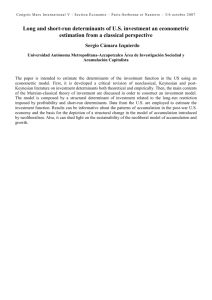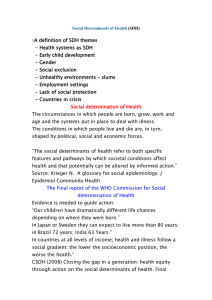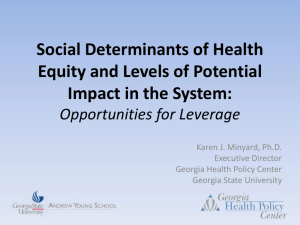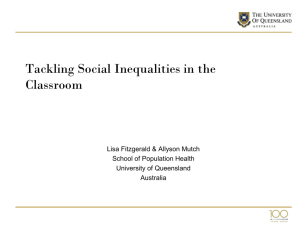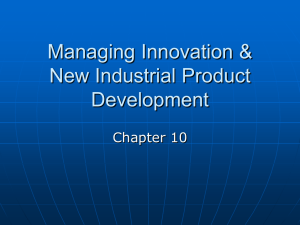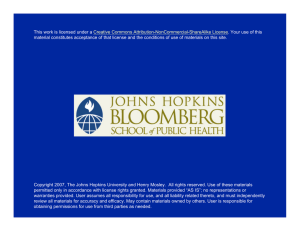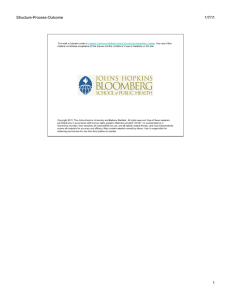world health & social determinants
advertisement
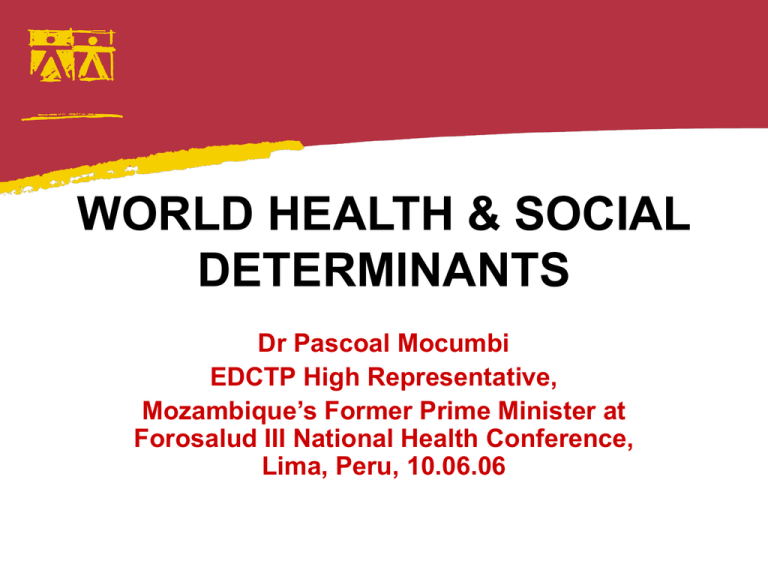
WORLD HEALTH & SOCIAL DETERMINANTS Dr Pascoal Mocumbi EDCTP High Representative, Mozambique’s Former Prime Minister at Forosalud III National Health Conference, Lima, Peru, 10.06.06 Mortality: 2002 estimates 30,000,000 25,000,000 20,000,000 15,000,000 I. Communicable diseases, maternal and perinatal conditions and nutritional deficiencies II. Noncommunicable conditions 10,000,000 III. Injuries 5,000,000 0 Source: WHO Burden of Disease estimates, 2002 Mortality Estimates for 2002 (World Health Report 2004) Infectious and Parasitic diseases •HIV/AIDS •Diarrhoeal diseases •Tuberculosis •Malaria •Childhood diseases •STI (excluding HIV) •Meningitis •(Other) Tropical Diseases •Hepatitis B •Hepatitis C •Dengue •Japanese encephalitis •Intestinal nematode •Leprosy 10 904 (000) 2 777 ¨ 1 798 ¨ 1 566 ¨ 1 272 ¨ 1 124 ¨ 180 ¨ 173 ¨ 129 ¨ 103 ¨ 54 ¨ 19 ¨ 14 ¨ 12 ¨ 6 ¨ LEADING CAUSES OF DISEASE BURDEN AMONG ADULTS (15-59) WORLDWIDE HIV/AIDS 68661 57843 Unipolar depressive disorders Tuberculosis 28380 27264 26155 Road traffic injuries Ischaemic heart disease Alcohol use disorders Hearing loss (adult onset) Violence Cerebrovascular disease Self-inflicted injuries 19567 19486 18962 18749 18522 0 World Health Report 2003 10000 20000 30000 40000 50000 60000 70000 80000 DALYS(000) 1 = <50% 2 = 50-80% 3 = 80-95% 4 = >95% 5 = No data available (36) (68) (33) (41) (1) UNDER 5 MORTALITY RATE PER 1000 LIVE BIRTHS SIERRA LEONE 316 BOLIVIA 80 KYRGYZSTAN 63 SRI LANKA 20 ICELAND 3 SOURCE: THE WORLD HEALTH REPORT 2004,WHO % PROBABILITY OF DYING BETWEEN AGES 15 AND 60 (males) LESOTHO 90.2 RUSSIA 46.9 BOLIVIA 26 SRI LANKA 23.8 COLOMBIA 23.6 PAKISTAN 22.7 SWEDEN 8.3 SOURCE: THE WORLD HEALTH REPORT 2004,WHO UNDER 5 MORTALITY RATES BY SOCIOECONOMIC QUINTILE OF HOUSEHOLD Under 5 mortality per 1000 200 150 100 50 0 Indonesia Poorest fifth 2nd richest fifth Brazil India 2nd poorest fifth Richest fifth Victora et al Lancet , 362, 233-241 (2003) Kenya Middle fifth MORTALITY AND EDUCATION IN MEN* AGED 45-90 IN MATLAB, BANGLADESH, 1982-1998 Own education Rate ratio Wife's education 1,05 1 0,95 0,9 0,85 0,8 0,75 0,7 0,65 0,6 None Koranic 1 to 4 years formal 5+ formal Education *married at entry (Hurt, Ronsmans & Saha JECH 2004, 58, 315-320) GROWING INEQUALITIES TRENDS IN PROBABILITY OF SURVIVAL IN RUSSIAN MEN BY EDUCATION (RELATIVES STUDY) elementary university 0,7 45 p 20 0,65 0,6 0,55 0,5 0,45 19 89 19 90 19 91 19 92 19 93 19 94 19 95 19 96 19 97 19 98 19 99 20 00 20 01 0,4 Calendar year 45 p20 = probability of living to 65 yrs when aged 20 yrs Murphy et al, in press A very complex health development landscape… • • • • Outcomes-based development "Scaling Up!" Growing rapidly: from millions to billions Predominant disease/intervention program (vertical) focus • Unsatisfactory performance of health systems 2005 Commission social Determinants of Health History: trends and opportunities 2000s: 2005 "pendulum swing" and new chance for action. Social dimensions of health affirmed in WHO Constitution (1948), downplayed during 1950s era of disease campaigns. Determinants re-emerge under Health for All agenda (1970s), action falters in 1980s. 1993 1982 1978 1948 1990s: paradigm of health as "private" issue dominant; some exceptions. 2002 2001 2000 ‘The causes of the causes’ Social Determinants and Health Disadvantage Source: Adapted from Diederichsen and Hallqvist 1998 Challenging inequities in health Social Context I Social Position II III Specific exposure Disease / injury Policy Context I Social Consequences of ill health IV What good does it do to treat people's illnesses ... then send them back to the conditions that made them sick? Social, political, economic and environmental threats to health identified as the basic causes of ill health and the inequitable distribution of health within and between countries have increased CSDH GOALS • To support policy change in countries by promoting models and practices that effectively address the social determinants of health. • To support countries in placing health as a shared goal to which many government departments and sectors of society contribute. • To help build a sustainable global movement for action on health equity and social determinants, linking governments, international organizations, research institutions, civil society and communities. A broad consultative process June 04: May 04: D-G Lee announces CSDH at WHA major meeting with int'l public health experts, London Jan 05: CSDH discussed at WHO Executive Board Dec 2003 Present From Feb 2004: consultations in WHO HQ and Regions From June 2004: outreach to civil society From July 2004: initial contacts with potential partner countries From Aug 2004: linking with UN agencies and projects (FAO, ILO, MP, etc) Equity and WHO • • • • Constitutional foundations 1948 Alma Ata Conference 1978 Equity Team created 2003 Commission on Social Determinants launched 2005, will report in 2008 "The underlying theme of my first year as DirectorGeneral is equity and social justice". Lee Jong-Wook, Address to the World Health Assembly, May 2004 PERU ForoSalud • Example of civil society involvement • III Conferencia Nacional de Salud: Voz Y Proposta Por el Derecho a la Salud 20062011- A call for action by government by a civil society movement that assumes its responsibility in promoting EQUAL OPPORTUNITIES TO HEALTH FOR ALL Muchas Gracias, Thank you!

